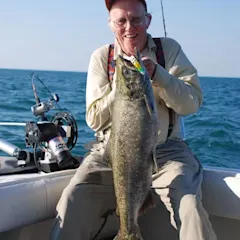Back in 1845, when Henry David Thoreau first moved to Massachusetts’ Walden Pond to confront the essential facts of life, one such encounter involved chain pickerel. The philosopher got all gushy over the colors of “this great gold and emerald fish,” while comparing its wildness to the superficial concerns of nearby suburban Concord. The paradox still pertains: Pickerel fishing remains fantastic sport, even in the land of soccer moms and shopping malls, and especially in the fall, when the fish begin an aggressive feed before winter.
**SEARCH THE SUBURBS **Chain pickerel have a deep green back blending to lighter green-and-gold sides that are covered by darker, graphic lines resembling the links of a chain, a pattern almost never shown by their larger pike and muskie cousins. They are found throughout most of the eastern half of the United States. The best fishing, with one exception, is found within the megalopolis stretching from Boston south to Washington, D.C. Just about every clattering commuter train along this corridor passes good pickerel water. In New Jersey, Massachusetts, and eastern Pennsylvania the pickerel fishing is great. Some of the brackish tidewater rivers in the Chesapeake Bay region are full of chainsides. The exception to this suburban rule is in Maine, especially in the Washington County region, where the outstanding pickerel fishing is overshadowed by small-mouth bass and landlocked salmon.
Pickerel also occur farther south–Georgia’s Okefenokee Swamp is a regional hotspot–but are typically less abundant there. Georgia did produce the current all-tackle record, though: a 9-pound 6-ounce fish taken near Homerville in 1961. The common denominator, wherever you find pickerel, is shallow, weedy water.
Look for them along any weed edges in lakes, ponds, or slow-moving rivers. They’ll lurk in beds of lily pads, for example, or in patches of aptly named pickerel weed. Woody cover such as downed timber or shoreline stumps will also hold fish. Most pickerel will be shallow, even in the summer, meaning less than 3 feet deep. The largest fish are sometimes deeper, though, and those I’ve taken larger than 24 inches have almost all come from a dropoff or channel edge near shallow-cover zones.
TACKLE AND TACTICSJust about anywhere, the majority of pickerel you’ll catch will be 15 to 19 inches long. Match your tackle to the quarry for the best sport. A medium- to lightweight spinning setup spooled with 6- or 8-pound mono-filament is perfect. Or you might choose a 9-foot, 6- or 7-weight fly rod with a floating line. Pickerel bristle with sharp teeth, but cut-offs–which do happen–are few simply because the fish aren’t that big. If you find your line getting sliced, use a short piece of the new, knottable leader wire (see sidebar) next to your lure or fly. Whatever you do, don’t use one of those wire-leader rigs with a snap and swivel at either end. Most pickerel novices seem to regard these as a must, but they stand out too much in clear water and will radically reduce your catch rate.
Among lures, pickerel will eat almost anything, but the venerable Johnson Silver Minnow is an ongoing favorite in sizes from ¼ down to 1/8 ounce. Adding a strip of white pork rind to this spoon boosts the wiggle factor and likewise your score. Soft-plastic jerkbaits like the Slug-Go and Zoom Fluke can also work well. For deep fish that tend to be fussy, twitching a Texas-rigged, 6-inch ribbon-tailed soft-plastic worm–black with a chartreuse tail–can be a deadly tactic. Note that the foregoing are all more or less weedless in deference to the pickerel’s cluttered living room.
Flyfishermen can do well with just about any bright streamer fly from 3 to 4 inches long, fished on a nylon leader tapered to about 8-pound-test. Do not use fluorocarbon leaders here; they sink more readily than nylon and frequently will tangle in the weeds. Most of my fly-caught pickerel over the years have come on an old-time Mickey Finn (red-and-yellow) bucktail, the hair of which is more durable than feather-based patterns.
By far the best approach with any tackle is to cast and retrieve parallel and close to the weed edges. You can seldom do this from shore, so either a boat or wading provides an advantage: Because pickerel usually hold in the weeds facing open water, this route will tempt the greatest number of fish with each cast. Faster, erratic retrieves are usually best, but it pays to experiment. Alternatively, and if you’re fishing from the bank, cast your weedless spoon into the vegetation and skitter it back along the tops before it sinks and tangles. Like bass, pickerel will sometimes blast through the weeds to nail a lure, but more often they’ll follow it to the edges, scarfing it as it hits open water.
FISH ON Some pickerel may jump when hooked; most will lunge for cover. You’ll have your hands full fighting one away from the weeds, as well as when you land one. Pickerel always seem to save their wildest thrashing for boat-side, and patience is key. Use a net or grab the fish with your thumb and fingers on either side of its head over–not inside–the gill covers. Needle-nose pliers are essential for hook removal.
Take a few seconds to admire the fish’s striking colors as they mirror the highlights and shadows of sunlit weedbeds. Later, on some winter night, that recollection just might make you a philosopher, too.
TEETH AND TIPPETSFine-diameter, multistrand leader wire that can be tied with common fishing knots makes it easy to add a bite tippet for toothy critters like pickerel. Add a few inches to your line or leader with a triple surgeon’s knot. Just be sure that the wire and main line are similar in diameter. Tyger leader wire (www.tygerleader.com) in 10-pound-test is .010 inch, for example, and mates well to 8-pound nylon that has the same nominal diameter. Surflon Micro Ultra from American Fishing Wire (www.americanfishingwire.com) in 11-pound-test is another good match. –J.M.


